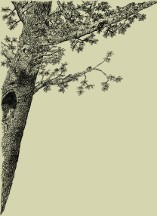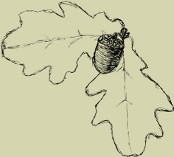42 41 40 39 38 37 36 35 34 33 32 31 30 29 28 27 26 25 24 23 22 21 20 19 18 17 16 15 14 13 12 11 10 9 8 7 6 5 4 3 2 1
Zeszyt 10 (1971)
The paper presents the (dynamic) method of wood examination when applying a non destructive sonic resonance on samples.
The presented method of determinations and calculations is based on an analysis of the course of forced transverse vibration of the sample tested. The following values characterizing viscous-elastic properties of wood were accepted:
1. phase angle tan γ,
2. complex dynamic modulus of elasticity E,
3. actual portion of the complex dynamic modulus of elasticity E1,
4. apparent portion of the complex dynamic modulus of elasticity with bending load E2,
5. dynamic viscosity η2,
6. time lag τ1.
The presented method makes it possible to determine the relationship between factors affecting wood properties without the destruction of material.
Studies were carried out on a set consisting of a string, resonator, and wooden coupling element. Board of spruce wood provided resonator.
The whole set was fixed in a cast iron construction with a very great bulk when compared with that of resonator and placed in a concrete bracket protecting it from vibrations transferred from room. Resonator was fixed in grips embracing two opposite narrow sides of a board, while the string — in special grips making possible its tuning. Tuning has been done with the aid of oscilloscope, while accepting as basic frequency of string the tuning fork sound a1 — 440 Hz.
String vibrations were initiated in two ways:
1. with electromagnetic technique,
2. with a jerk of pizzicato type.
Above the spot of string excitation microphone was placed at the distance of circa 5 cm. Sounds produced were registered on magnetic tape tape, and then subjected to oscillographic and spectral analysis. Spectral analysis was carried out with the aid of filter analyzer, while the registration of spectra was done with photographic technique.
While using both methods there were obtained curves of the transfer of vibrating system within the range from 300 Hz to 4500 Hz as well as peak spectra separately for the five subsequently excited sounds a1. Measurements were taken on 54 plates. Wood density was calculated for each plate. With the aid of microscope measurements of ring width were taken and percentual proportion of late wood was calculated separately for each plate.
Based on obtained technological data as well as on oscillograph records and spectra of sounds excited there was attempted a determination of correlation between the course of intensities of strengthened ranges of frequency, sometimes deformations of sounds, intensity of the base tone, distribution of resonances in spectrum and the thickness intensity of resonating boards, its density, ring widths, and proportion of late wood.
As a result of experiments and statistical analysis we rained to found that the density of spruce wood, ring width, and proportion of late wood, varying within limits permitted by the standard for resonance wood, affect in a significant way the acoustic parameters studied.
Tested saws had diameters from 314 to 497 mm, thickness — from 1.94 to 3.56 mm and working speed of 1000 to 4000 rpm.
Values of effective induction ought to be experimentally selected in relation to dimension and rotational speed of the saw.
Obtained results of the reduction in noise level were contained within limits of 0-15 dB for all the examined cases.
Maximum effects of noise damping were obtained when the rotational motion of the saw induced strong vibration with high frequency.
The paper deals with the subject of modification of birch, beech and oak wood with the application of methyl methacrylate, styrene and vinyl acetate monomers polymerized in wooden tissue by heating method and use of benzoyl peroxide as an initiating agent.
Heat polymerization method was chosen as a subject of investigation because its application on commercial scale in the manufacture of wood-plastic composite is preferable from financial point of view as the investment outlay needed is only one fourth of that necessary for the production of improved wood with the application of radiation polymerization method. Besides, as it was found, the method of polymerization (by heat or radiation) does not influence the properties of modified wood.
Analysis of results obtained in the course of investigation showed that styrene and methyl methacrylate monomers are more effective in dimension stabilization of modified wood than vinyl acetate monomer. Wood-plastic composite obtained form the combination of wood and vinyl acetate was characteristic by higher hygroscopicity and water absorption ability in comparison with wood combined with polystyrene or methyl polymethacrylate. It is supposed that in the course of vinyl acetate polymerization, the conversion degree is lower than that occurring in the polymerization of either styrene or methyl methacrylate monomers.
Wood impregnated at the same time with all three monomers (MM + ST + VA) featured the like improvement in dimensional stability as wood combined only with polystyrene or methyl polymethacrylate and, in some instances, was characteristic by high index of swelling decrease.
In the face of these findings it is justifiable to carry out further investigations on the modification of wood by the impregnation with two or more monomers with different weight ratio at the same time, followed by heat polymerization in the wooden tissue.
The paper presents results of observations on the behaviour and development of S. domesticus under various conditions of temperature and describes methods of its massy laboratory culture on larvae of numerous species from Cerambycidae and Anobiidae families. Research results indicate that S. domesticus may be used in biological control of insects destroying wooden constructions and products. This species is easy to produce in the way of massy laboratory cultures. In order to get food for complementary feeding and to deposit eggs it finds and destroys larvae situated even at the greatest depth in wood. In endless search after victims it is extraordinarily active and aggressive and destroys larvae of all species and any size which are to be found in wood. It reveals a high capacity for survival in unfavorable conditions, except of temperatures below 0°C. Activity of S. domesticus breeding is to a serious extent dependent, however, on the temperature of surrounding. The paper presented possibilities of the use of this parasite in the biological control of insects feeding in wood depending upon room temperature and thermal conditions in which wooden objects are situated. In objects in which control with the use of S. domesticus larvae is intended the parasite is introduced in block in which it developed on host larvae set there previously. Negative aspects of this kind of control include the high susceptibility of S. domesticus to low temperatures and the fact that it fails to destroy beetles staying in wood. It may be troublesome in case of its great numbers in lodgings, because females sting human bodies in places with sensitive skin. Impression caused by the sting abates quite soon.
The purpose of the work was to find what is the possibility of the substitution of Hylotrupes bajulus L. larvae by those of Criocephalus rusticus L. and Leptura rubra L. in determination of the limiting insecticide value of wood preserving means.
One- and two-years-old larvae of C. rusticus reveal too low ability of adaptation to a new environment and due to this they perish in masses even in blocks not treated with poisonous materials. Most probably they show also by far greater susceptibility to the action of wood preserving means. Due to above reasons they could not be used in the determination of the limiting insecticide value of wood preserving means.
One- and two-years-old larvae of L. rubra show a lower ability of adaptation to new environment and higher susceptibility to the action of wood preserving means when compared with H. bajulus. Hence limiting insecticide values of preparation determined with the use of L. rubra larvae cannot provide basis for the section of these preparation for production and marketing. Such basis may provide limiting insecticide values determined with the use of H. bajulus larvae.
On the other hand L. rubra larvae may be widely used for the determination of limiting insecticide values in preliminary studies on newly formulated means of wood protection. The purpose of such studies would be to eliminate from further experiments such preparations which appeared to be not poisonous or poorly effective even against L. rubra larvae. Preliminary studies require the greatest number of larvae. The use of L. rubra larvae at this stage of experimentation effectively reduces the necessity of handling large numbers of hardly available H. bajulus larvae, and thus enables the extension of developmental research in wood preserving means.
While using L. rubra larvae in introductory studies one should set them in twice as great number of experimental and control blocks than in the case of H. bajulus. Blocks with larvae ought to be kept in the temperature of 20-22°C and at ca 95% relative air humidity. In spite of the doubled number of blocks experiments carried out with the use of L. rubra larvae are less arduous then in the case of H. bajulus larvae, owing to availability of large number of L. rubra larvae. These larvae occur quite numerously in stumps of coniferous trees almost in each forest. Thus there is not need of laboratory culture of larvae.
Studies on the mycoflora of pine cuttings and sawdust stored in piles on an open have been carried out for several years. As a result of carried out introductory studies there was found the presence in sawdust piles of 37 fungal species, excluding several strains of not yielding spores mycelia and certain number of cultures with characteristics of yeasts.
Fungal flora developing in the surface layer of sawdust piles is diversified and in respect to its species composition it takes an intermediate position between the mycoflora of soil and that of wood. Common and broadly spread species from genera Trichoderma, Penicilium, Glicladium, Paecilomyces prevail in it, as well as wood staining species from families Dematiaceae and Stilbaceae, as also certain yeast species and single species of soil fungi, being rather accidental elements, In this pile layer no fundamental changes in mycoflora were noted in relation to the duration of sawdust storage.
In the inner layer where temperature reached 90°C, developed few species, different depending upon the time of sampling. The most common species in this layer were Paecilomyces herbarum Brown et Smith, Penicillium diversum var. aureum Rap. et Fenn and at the final stage of sampling — Penicillium roseo-purpureum Dierck.
Studies concerned the impregnation of spruce wood with fungicides of Polish production. Wood samples with three grades of moisture (15, 28, and 50%) were saturated in aqueous solutions of five salt preparations with 4% (sodium fluoride) and 10% concentration (Fungonit GF-2, Fungonit NW, Fluotox, and Soltox 5F) and in one oily agent — Xylamit Popularny, with the use of bath technique. Following durations of bath were used: 5, 15, 30, 60, and 120 minutes and following temperatures of dilutions: 20, 40, 60, and 80°C.
Results of saturation were characterized by the depth of penetration in mm, quantity of absorbed preparation in g of salt per m2 (g of oil per m2) and the distribution of Fungonit GF-2 salt (wood was saturated by solutions with 5, 10, 20, and 30% concentrations) at the depth of penetration, in % and in kg of salt per m3 of wood.
The penetration of Xylamit Popularny into spruce wood was restricted to the superficial coloration of wood. Salt preparation penetrated the spruce wood at the depth from 0.9 to 10.5 mm depending upon conditions of saturation and a wood zone (sapwood, heartwood). The distribution of Fungonit GF-2 at the depth of penetration was uneven; the greatest amount of salt was contained in surface layer and along with the increase in depth the quantity of salt decreased until it disappeared completely.
Microscopic studies were carried out on the distribution of five oily agents of Polish production with following trade names: Xylamit Popularny, Xylamit Super, Xylamit Super W, Xylamit Żeglarski, and Xylamit Destylowany Stolarski. Wood was impregnated with fungicides according to the standard PN-61/C-04901. Oil distribution was examined on three sections of wood, namely: cross-section, longitudinal radial section, and longitudinal tangent section. Results of examinations were illustrated by microscopic photograms.
Examined oily fungicides were distributed unevenly; the oil of concentrated in pith, in vessels of late wood, and in certain envelope cavities of an early wood.















 Pobierz PDF
Pobierz PDF